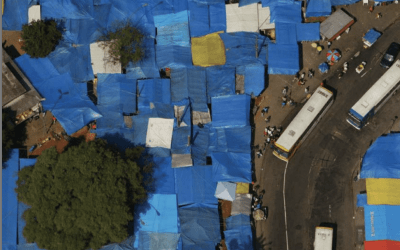The Rise and Fall of Brazilian Inequality
A Summary
Although Brazil remains one of the world’s most unequal countries, new research shows that the period between 1993 and 2004 (which saw the restoration of macroeconomic stability, and a modest resumption in growth) was also marked by sustained—if unspectacular—declines in inequality. Although the 2004 figures confirm that Brazil’s inequality level continues to be very high by international standards, its distribution of household per capita incomes has not been as stable over the last two and a half decades as previously thought. Changes in the Gini coefficient, a commonly used measure of inequality, tell an interesting story about Brazil.
During the 1980s, Brazil’s Gini coefficient for the distribution of household per capita income rose from 0.574 in 1981 to 0.625 in 1989. After that five-point (or 9%) increase during the 1980s, Brazil’s inequality was the second highest in the world, narrowly behind Sierra Leone (although such international comparisons are fraught with technical difficulties, given differences in survey methods across countries). From this peak in 1989, Brazil’s Gini fell by six points, or roughly 10%, to 0.564 in 2004. These are not insubstantial changes.
Over the same period, poverty also followed a non-linear evolution, rising during the 1982-1983 recession, falling sharply during the mid-1980s recovery and the Cruzado stabilization plan of 1986, and then rising again at the end of the decade. At least in terms of income poverty reduction, the 1980s really were a lost decade for Brazil: poverty was still higher in 1993, the year which preceded successful economic stabilization, than it had been in 1981. In the ten years following the Real Plan of 1994, poverty fell steadily, by various measures and lines. By the standards of an “administrative poverty line” of R$100 per capita per month, incidence fell by ten percentage points, or a third (see Table 1).
Table 1. Brazil 1981-2004: Incomes and Inequality in Select Years
|
Year |
Mean |
Median |
Gini |
Regional |
“Administrative |
|
1981 |
336.7 |
173.2 |
0.574 |
0.399 |
0.296 |
|
1989 |
382.7 |
170.6 |
0.625 |
0.437 |
0.315 |
|
1993 |
320.7 |
157.2 |
0.595 |
0.466 |
0.326 |
|
1997 |
401.2 |
198.3 |
0.593 |
0.370 |
0.273 |
|
2004 |
393.9 |
210.0 |
0.564 |
0.345 |
0.222 |
Notes:
* Incomes are monthly household incomes per capita, measured in September 2004 Brazilian Reais with a dollar exchange rate of BR$/US$ = 2.89.
** A set of regionally-specific poverty lines calculated by Rocha (1993).
*** The “administrative poverty line” is set as R$100 per person per month, in September 2004 values. R$100 per capita per month (in 2004 values) is also the means-test in Brazil’s main new cash assistance program, Bolsa Família.
Sources: Authors’ calculations from surveys of the Pesquisa Nacional por Amostra de Domicílios (PNAD).
THE RISE OF INEQUALITY FROM 1981 TO 1993
The outstanding economic fact of the 1980s in Brazil was macroeconomic instability and, in particular, hyperinflation. The annual inflation rate accelerated from 80% in 1980 to 1509% in 1990. Volatility in the real economy was also pronounced, with a deep recession between 1981 and 1983, followed by a brief two-year recovery and then a price freeze in 1986, aimed to reduce inflation. When the government abandoned the failed Cruzado stabilization plan, however, inflation surged again in 1987 and most measures of household income per capital fell.
The increase in inequality in the 1980s appear to have been driven, in large part, by high and accelerating inflation. While the distributional impact of inflation is hard to measure, or even to simulate counterfactually, inflation is likely to have a regressive impact on the distribution of income for two reasons. Firstly, the inflation tax tends to be a regressive wealth tax, since the ability to protect wealth through portfolio adjustments is generally held to be increasing in income, at least over an initial range. In addition, there is some evidence that indexation in the labor markets is not perfect, and that the real wages of poorer workers may lag behind during high-inflation periods.
The evidence also suggests that the rise in inequality during this period also resulted from the gradual expansion in the educational levels of the labor force. Due to the convex nature of the returns to schooling in Brazil, with rising marginal returns to each additional year of schooling, the expansion in the levels of formal education in the labor force—which helps increase productivity and reduce poverty—can nevertheless lead to greater inequality between educational sub-groups of the population. This tendency was partly, but not entirely, offset by declines in the return to schooling, which arose from this increase in the supply of more skilled workers.
THE DECLINE IN INEQUALITY BETWEEN 1993 AND 2004
The restoration of macroeconomic stability in 1994 was followed by sustained—if unspectacular—declines in inequality. While most of the contemporaneous decline in poverty was driven by Brazil’s (modest) economic growth, the decline in inequality did also contribute. In fact, inequality reduction during 1993-2004 accounted for almost half of the decline in the more bottom-sensitive poverty measures, like the squared poverty gap.
Inequality decomposition analysis suggests that three main forces combined to reduce income inequality from 1993 onwards. First, the single most important correlate of individual incomes in Brazil, as in most of Latin America, is educational attainment. In fact, the data indicates that over a third of overall inequality in Brazil can be accounted for by differences across five groups of households, sorted by the education of the head. Interestingly, there is some evidence that this share, while still very significant, has been falling, due to a secular decline in average returns to schooling over the last two decades.
Second, there has been a remarkable convergence in household incomes between the country’s rural and urban areas, which has replaced and added to the inter-state convergence that had been documented until the mid-1980s. Though meriting further research, the convergence of rural-urban incomes is consistent with the sectoral evidence on agricultural and agriculture-related business growth in Brazil since the trade liberalization of the early 1990s.
Third, a decomposition of inequality by income sources—such as employment earnings (formal and informal); self-employment incomes; labor incomes of employers; social insurance transfers; and a residual category that consists largely of capital incomes and social assistance transfers—suggests that receipts of cash-based social assistance transfers from the government has become much more widespread. There is also evidence that these transfers have become better targeted to the poor. From 1993 to 2004, mean “other” incomes have risen, and their inequality level has fallen substantially. The population share receiving incomes from this source has almost doubled, from 16% to 30%, and inequality among recipients has fallen. Perhaps most tellingly, the correlation between this income source and total income has fallen from 40% to 30%. While it is possible that these changes reflect changes in the distribution (or the reporting) of capital or rental incomes, it is more likely that they reflect, at least in part, the substantial expansion of Brazil’s cash-based social assistance system, beginning with the Projeto Alvorada in 1994-95, the launch of the National Bolsa Escola and Bolsa Alimentação programs in 2000, and their integration into the Bolsa Família in 2003.
In addition to these three “structural” and policy processes, the macroeconomic stability ushered in by the Real Plan of 1994 has eliminated the contribution from hyper-inflation to inequality, which was present in the previous sub-period. But the news is not all good. While earnings from employment still account for the largest share of total household per capita incomes in Brazil, its share as a proportion of total income declined from almost 60% in 1981 to 50% in 2004. A similar downward trend was observed for self-employment incomes during the period. These declining shares were offset by rising shares for the labor income of employers and, most importantly, for social security incomes. The share of social security transfers in total income doubled from 10% in 1981 to 20% in 2004, reflecting both the ageing of the population and the expansion and growing generosity of Brazil’s social security system (which is therefore likely to be unsustainable). Unfortunately, this expansion has taken place in a regressive manner, with the correlation between social security incomes and total household incomes rising from 0.36 in 1981 to 0.44 in 2004.
FURTHER RESEARCH IS NECESSARY
Poverty dynamics in Brazil were marked by considerable volatility between 1981 and 1993, largely as a reflection of the country’s macroeconomic turmoil over that period. In 1993, the incidence of poverty was higher than it had been at the beginning of the 1980s. Against that background, solid evidence of a reasonably sustained and statistically significant decline in inequality and poverty since 1993-94 is cause for cautious celebration. These changes remind us that, although resilient, Brazil’s inequality is not immutable. It responds both to structural economic and demographic transformations, and to policy.
Nonetheless, a more detailed analysis of the 1993-2004 inequality decline is a priority for future research. Several critical questions merit further exploration, including an examination of the general equilibrium factors behind the decline in returns to education in Brazil. A moredisaggregated analysis of the incidence of social assistance transfers—particularly of the Bolsa Família program—is also needed. Finally, it is also important to examine what lies behind Brazil’s remarkable rural-urban convergence over the last two decades. To what extent were these changes driven by the growth of the modern agricultural export sector, ignited perhaps by the trade liberalization of the early 1990s, and supported thereafter by high international commodity prices? Or are they due instead to greater access to land among small-holders, including those who have benefited from the ongoing land-reform initiatives? Finally, did the expansion of social security coverage in rural areas associated with the “aposentadorias rurais” play a role?
Interested readers should watch out for a forthcoming two-volume compilation of studies on these issues, which will be published by Brazil’s Instituto de Pesquisa Econômica Aplicada (IPEA), in the next few months. Those studies mark a major contribution to this research agenda, and begin to answer some of the questions left unanswered here.
This article is a non-technical summary of a longer research paper by the same authors, entitled “The Rise and Fall of Brazilian Inequality: 1981-2004”, which is forthcoming in Macroeconomic Dynamics, a journal published by Cambridge University Press. We are grateful to the publishers and the editor, Prof. William A. Barnett, for permission for the publication of this summary.
Spring 2007, Volume VI, Number 3
Francisco H.G. Ferreira is a Lead Economist at the Research Department of the World Bank, in Washington, DC.
Phillippe G. Leite is a Consultant with the Research Department of the World Bank, in Washington, DC.
Julie A. Litchfield is a Senior Lecturer in the Department of Economics at the University of Sussex.
Related Articles
Violence Against Women in Brazil: Public Policy and its Implementation in Rural Areas
English + Português
Eight o’clock in the evening—it’s time to gather and watch the national news program in Rio de Janeiro, Brazil.
2022: Uma Encruzilhada Histórica
English + Português
Este segundo turno da eleição 2022 no Brasil é um embate histórico entre visões de mundo. Entre concepções de vida e seus sistemas de valores. Você vai eleger (etimologia: escolher) em que mundo seria concebível viver.
Editor’s Letter: Brazil
Brazil is different. Brazil is huge. Brazil is colorful. Brazil is magic. In Brazil, the people speak Portuguese instead of Spanish.





